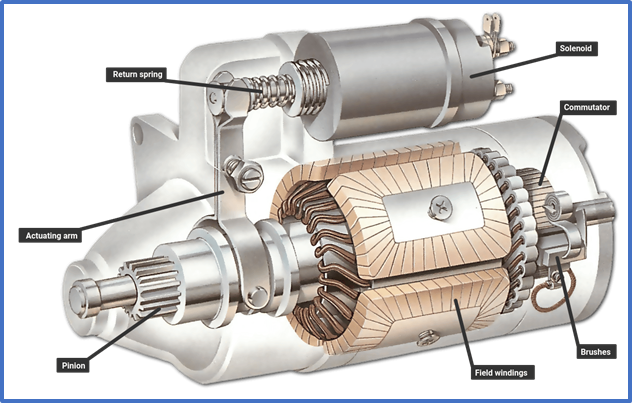WHAT IS A STARTER?
Your battery powers the starter, and the purpose of the starter is to engage the engine and get the vehicle going. The starter comprises two parts: the primary motor and solenoid. The primary motor turns the crankshaft and starts the engine, and the solenoid (or relay) engages the starter's drive gear and closes the main motor's electrical connections. If either one of the two parts stops working at any given time, you cannot move your car without a jumpstart or tow.
A starting problem can be caused by poor maintenance or normal wear and tear. As you can guess, a starter gets a lot of wear during its lifetime, so issues are common when a vehicle gets old.

WHAT CAUSES STARTER PROBLEMS
A variety of problems can lead to a bad starter, including:
- Loose wiring to and from the starter
- Dirty or corroded connections at the starter
- Battery corrosion
- Damaged or worn-out parts in the starter system
- Oil leaks
- Bad relay or fuse
BAD STARTER SYMPTOMS
·SOMETHING SOUNDS OFF: One of the symptoms of a bad starter is a clicking noise when you turn the key or push the start button. However, a starter can die without making any sound at all, or it may announce its impending death with whirring and grinding noise—so listen up!
·NO CRANK: Is your engine not revving up, even after attempting a jumpstart? At this point, it’s time to call the tow truck!
·LIGHTS BUT NO START: If you try to start the engine only to find that the dashboard lights up, but the engine doesn’t power up, you might have a problem with the starter.
·UNUSUAL NOISES: These can be described as clinking, grinding and whirring. If you ignore these sounds, it can eventually lead to damage to the engine flywheel.
·INTERMITTENT PROBLEMS STARTING THE CAR: If you are starting your vehicle and the engine doesn't ignite right away, and it works the second attempt, you are more than likely dealing with a problem with the starter relay.
·SMOKE: The starter is part of your car’s electrical system and subject to blown fuses and short circuits. When you’ve been desperately attempting to start your car, the starter can overheat making electrical issues—and the accompanying smoke—more likely. If you see or smell smoke, call for help rather than turning the key harder, again!
·OIL/MOISTURE: Your starter can usually be found on the passenger's side (if RWD) of the engine, just below the exhaust manifold. Or if it is FWD, check on the drivers side above the transmission or under the exhaust manifold. They can also be located just under the intake manifold on some vehicles.
WHAT TO DO WITH STARTER ISSUES
Whatever you do, don't wait for it to fail. Get your vehicle in as soon as possible to minimize the damage and get your car running in peak performance once again.
The skilled mechanics at Hillside Auto repair will be available when and if you need us. Call to discuss your auto repair issues and schedule diagnostic testing today to keep your days uninterrupted and your car running smooth! We are the Professionals You Can Trust!